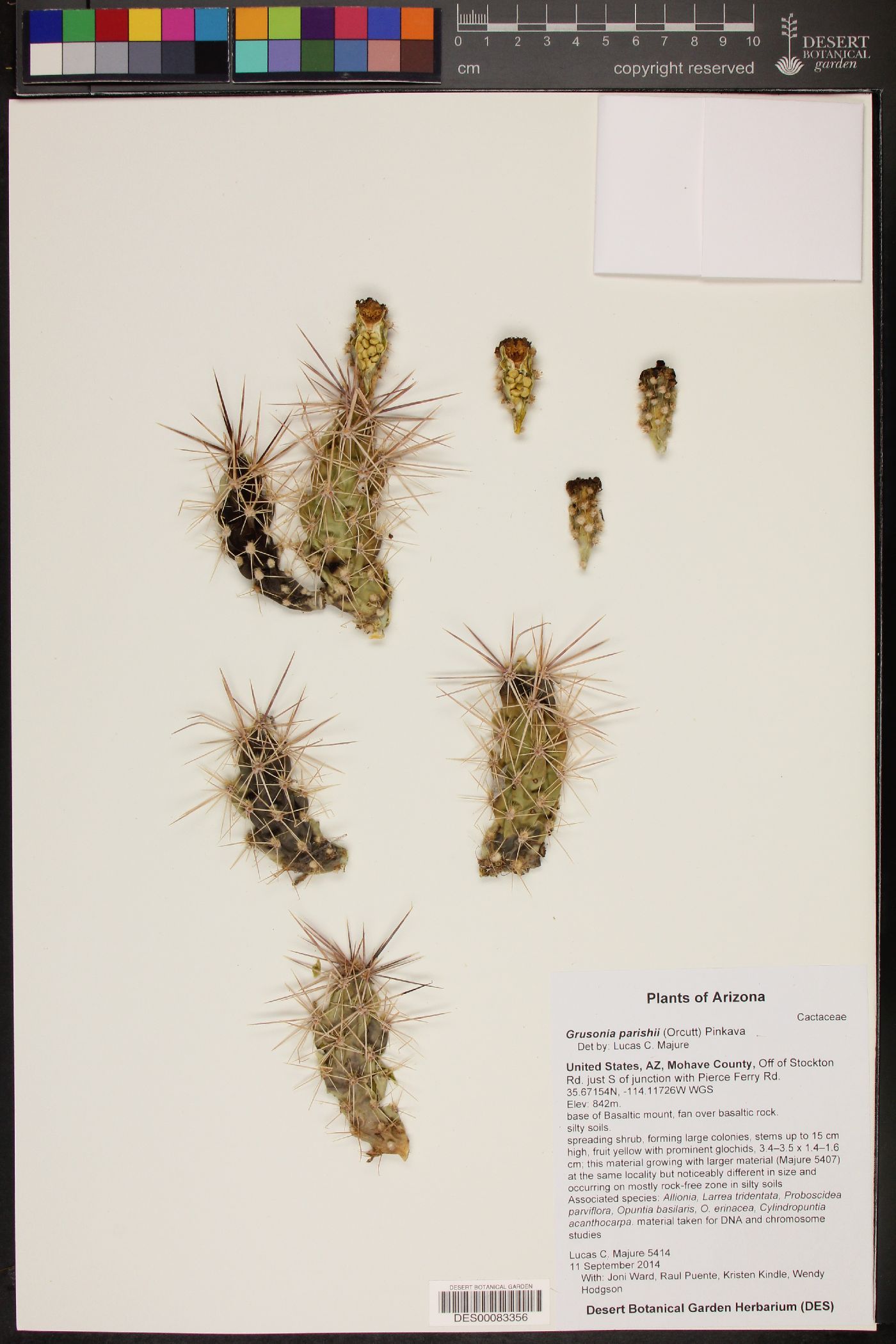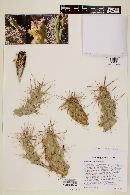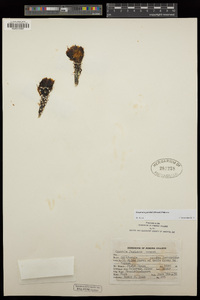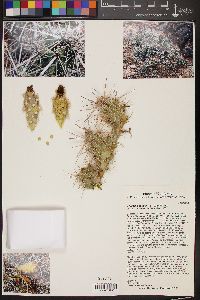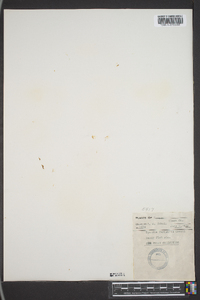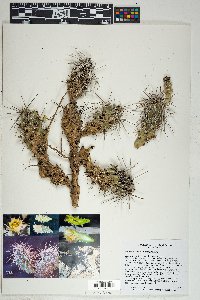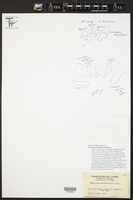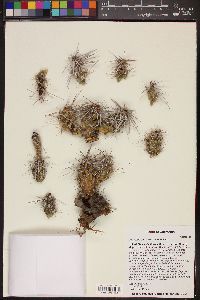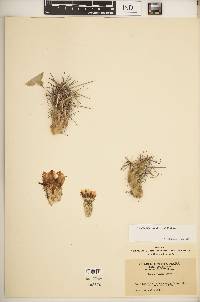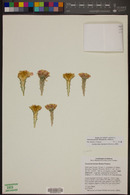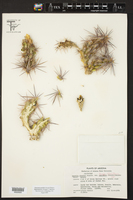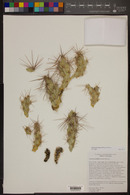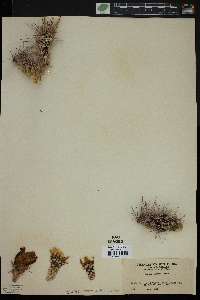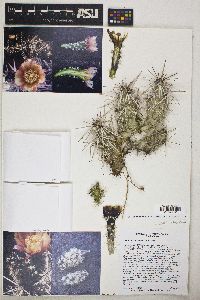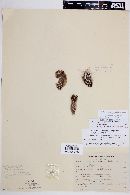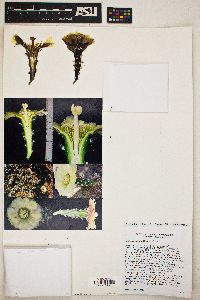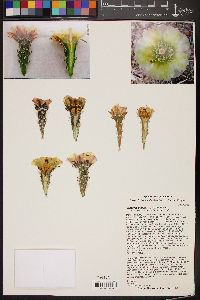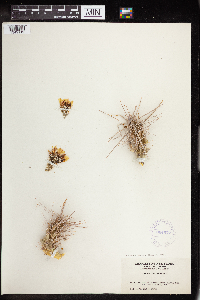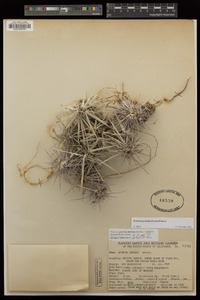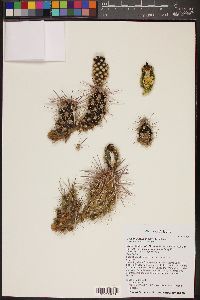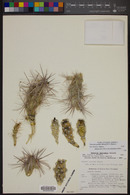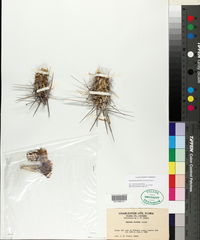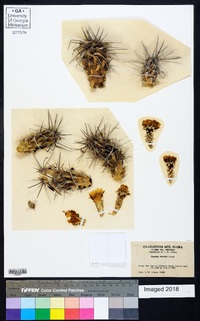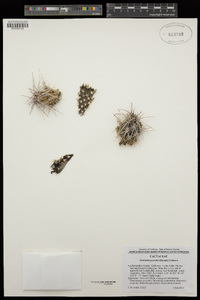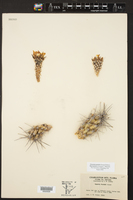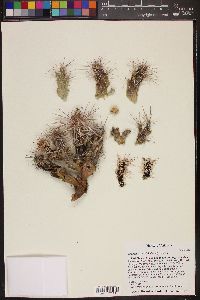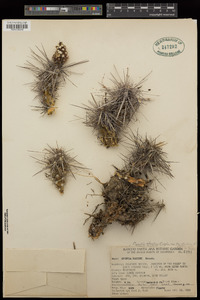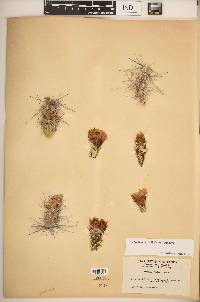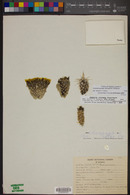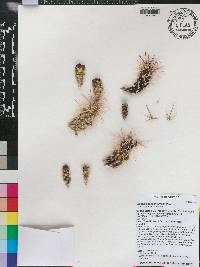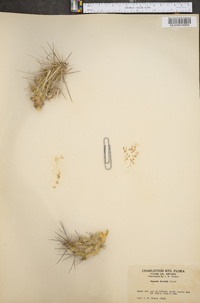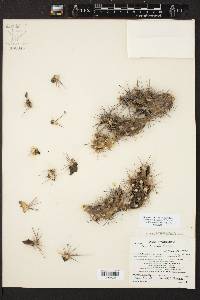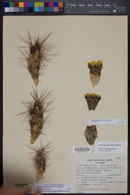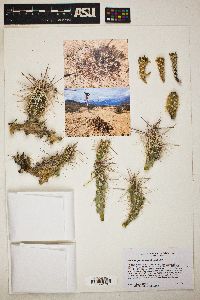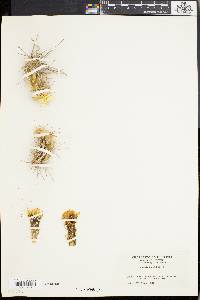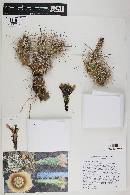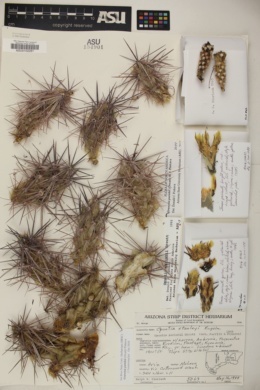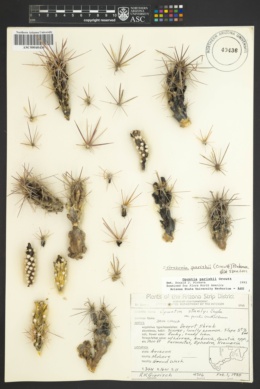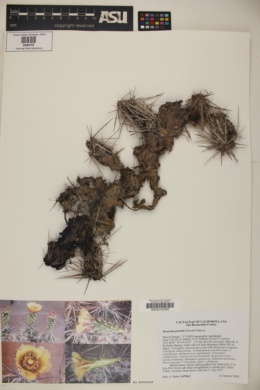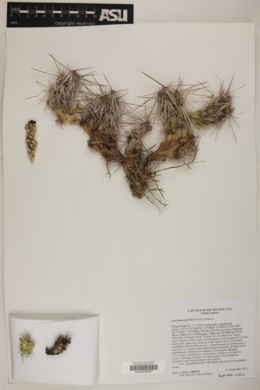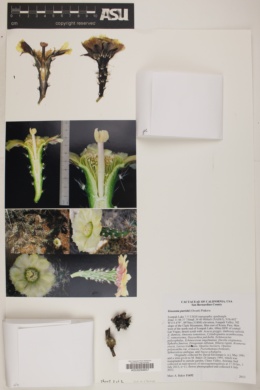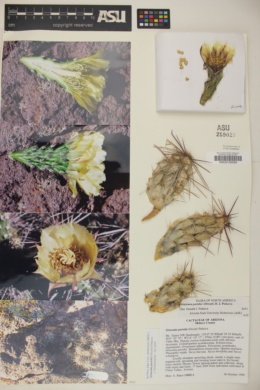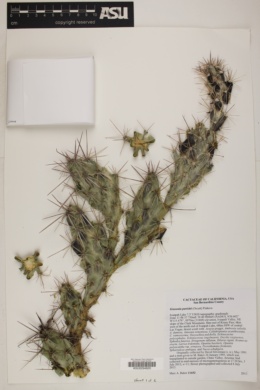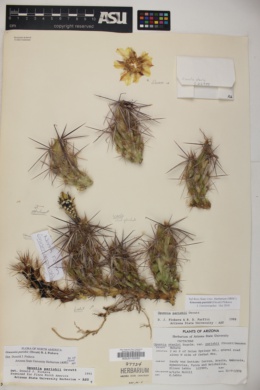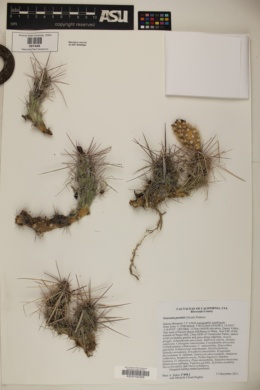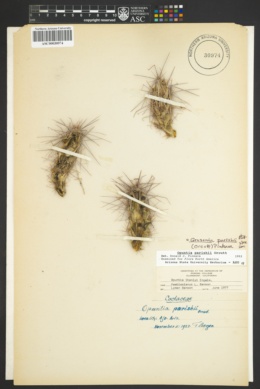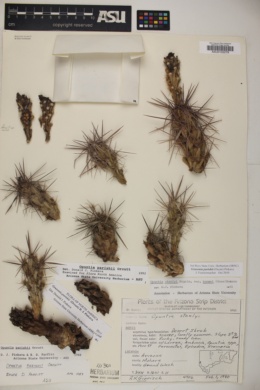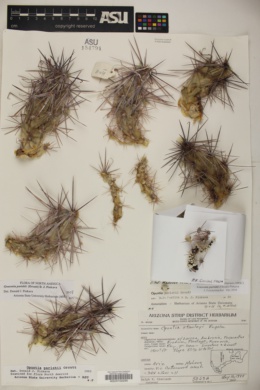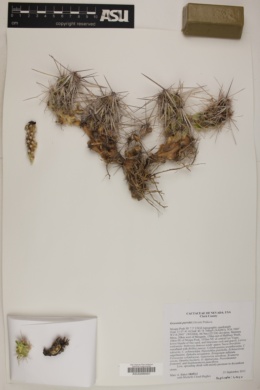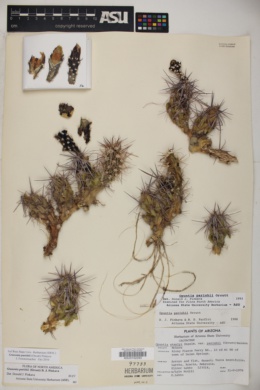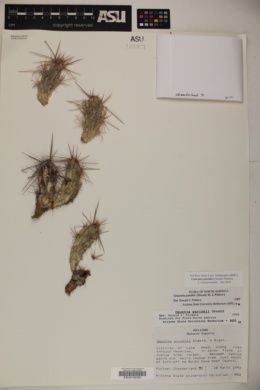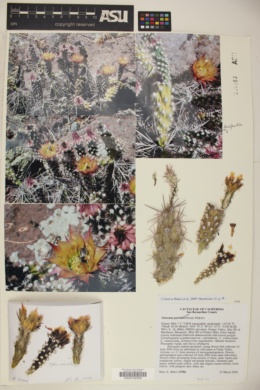
|
|
|
|
Family: Cactaceae
matted cholla, more...Matted Club-Cholla
[Opuntia parishii Orcutt, moreOpuntia stanlyi var. parishii (Orcutt) L. Benson] |
Shrubs, forming mats, 10-20 cm in series of usually 1-2 stem segments. Roots diffuse. Stem segments clavate, 5-9 × 2-3 cm; tubercles prominent, 15-25 mm, narrow, 4-6 times longer than wide, obscured by interlacing spines; areoles 5 mm in diam.; wool grayish white. Spines 14-17(-22) per areole, mostly in distal areoles or ± uniformly distributed, white to brownish, tipped yellow; major 5-6 abaxial spines strongly deflexed, flattened, longest white margined, 25-45(-58) mm; central spine brown or white, long tapered; major ca. 5 adaxial spines divergent, blackish or brown to tan, subterete, angular-flattened at base, longest to 42 mm. Glochids adaxial in areoles, yellow, 5-8 mm. Flowers: inner tepals pale yellow with narrow reddish midstripes, 15-22 mm; filaments pinkish or greenish to pale yellow; style whitish to pale yellow or dull pinkish; stigma lobes white, greenish white or pale yellow. Fruits yellow, 35-55 × 15-20 mm, fleshy, spineless, densely yellow glochidiate; areoles 35-52. Seeds yellowish white, 4-4.5 × 3.5-4.5 mm, smooth. 2n = 22. Flowering late spring-early summer (May-Jul). Mojave and Sonoran deserts, silty, sandy, or gravelly flats, dunelets, hills; 300-900 m; Ariz., Calif., Nev. L. D. Benson (1969) segregated plants of the southern Arizona populations, which are less robust than the others, as 'Opuntia stanlyi var. peeblesiana;' unfortunately he included with its type other specimens that belong to Grusonia kunzei. Diploid plants of G. parishii have spineless (but glochidate) fruits; tetraploid plants of G. kunzei have spiny and glochidate fruits.
Plant: Mat-forming shrub, low, much-branched, 10-20 cm tall; STEM segments clavate, 5-9 cm long, 2-3 cm in diam.; tubercles prominent, 1.5-2.5 cm long. AREOLES grayish white-felty, sub-circular, ca. 5 mm in diam Leaves: SPINES mostly in distal areoles to well distributed, white to brownish, yellow-tipped, 14-17(-22) per areole; major apical spines ca. 5, brownish, divergent, subterete, angular-flattened at base, the largest to 4.2 cm long; major 5-6 basal spines whitish, pinkish or tan-centered, strongly deflexed, flattened, the largest white-margined, 2.5-4.5(-5.8) cm long. GLOCHIDS yellow, distal in areole, 5-8 mm long Flowers: inner tepals pale yellow with narrow reddish center line, 1.5-2.2 cm long; filaments pinkish or greenish to pale yellow, the anthers pale yellow to yellow; style whitish to pale yellow or dull pinkish; stigmas white, greenish-white to pale yellow Fruit: yellow, fleshy, 3.5-5.5 cm long, 1.5-2 cm in diam., spineless but densely yellow-glochidiate; 35-52. SEEDS yellowish-white, smooth, 4-4.5 mm long, 3.5-4.5 mm wide Misc: deserts, silty, sandy to gravelly flats, dunelets and hills; 350-900 m (1200-2900 ft); May-Jul REFERENCES: Pinkava, Donald J. 1999. Cactaceae. Ariz. - Nev. Acad. Sci. 32(1). FNA 2003 Common Name: matted cholla Duration: Perennial Protected Status: Salvage restricted status in Arizona. General: Mat forming to 10-20 cm in series of 1-2 segments with the stem segments 5-9 cm and 2-3 cm diameter and club shaped with prominent tubercles that are 15-25 mm and narrow,the areoles to 5 mm diameter with grayish white wool. Spines: Spines obscuring tubercles usually 14-17+ and mostly in distal areoles, these white to brownish and tipped yellow with major abaxial spines strongly deflexed and flattened, 25-45+ mm with the central spine brown or white and long tapered, the major adaxial spines about 5 in number and divergent while being blackish to brownish-tan, with the yellow glochids adaxial in areoles about 5-8 mm. Flowers: Inner tepals pale yellow with reddish midstripes and 15-22 mm long with pink to green or pale yellow filaments, a white to yellow or pink style and stigma lobes that are white, green, or yellow. Fruits: Fleshy fruits yellow and 35-55 mm long by 15-20 mm diameter, spineless but densely covered with yellow glochids. Ecology: Found on silty, sandy, or gravelly flats, dunes, and hills in the the Mojave and Sonoran deserts from 1,000-3,000 ft (305-914 m), flowers May-July. Notes: FNA notes that Benson (1969) segregated plants of the southern Arizona populations, and included in the segregation specimens belonging to Grusonia kunzei. G. parishii plants are diploid, with spineless but glochidate fruits, and G. kunzei plants are tetraploid with spiny and glochidate fruits. Ethnobotany: Unknown Etymology: Grusonia is named for the German Herman August Jacques Gruson (1821-1895), who had a particular interest in the Cactaceae family, while parishii is named for brothers Samuel Bonsall Parish (1838-1928) and William Fletcher Parish (1840-1918), who were botanical collectors in California. Synonyms: Opuntia emoryi, Opuntia parishii, Opuntia stanleyi Editor: LCrumbacher 2010 |
This project was made possible in part by the Institute of Museum and Library Services [MG-70-19-0057-19].
Powered by Symbiota

